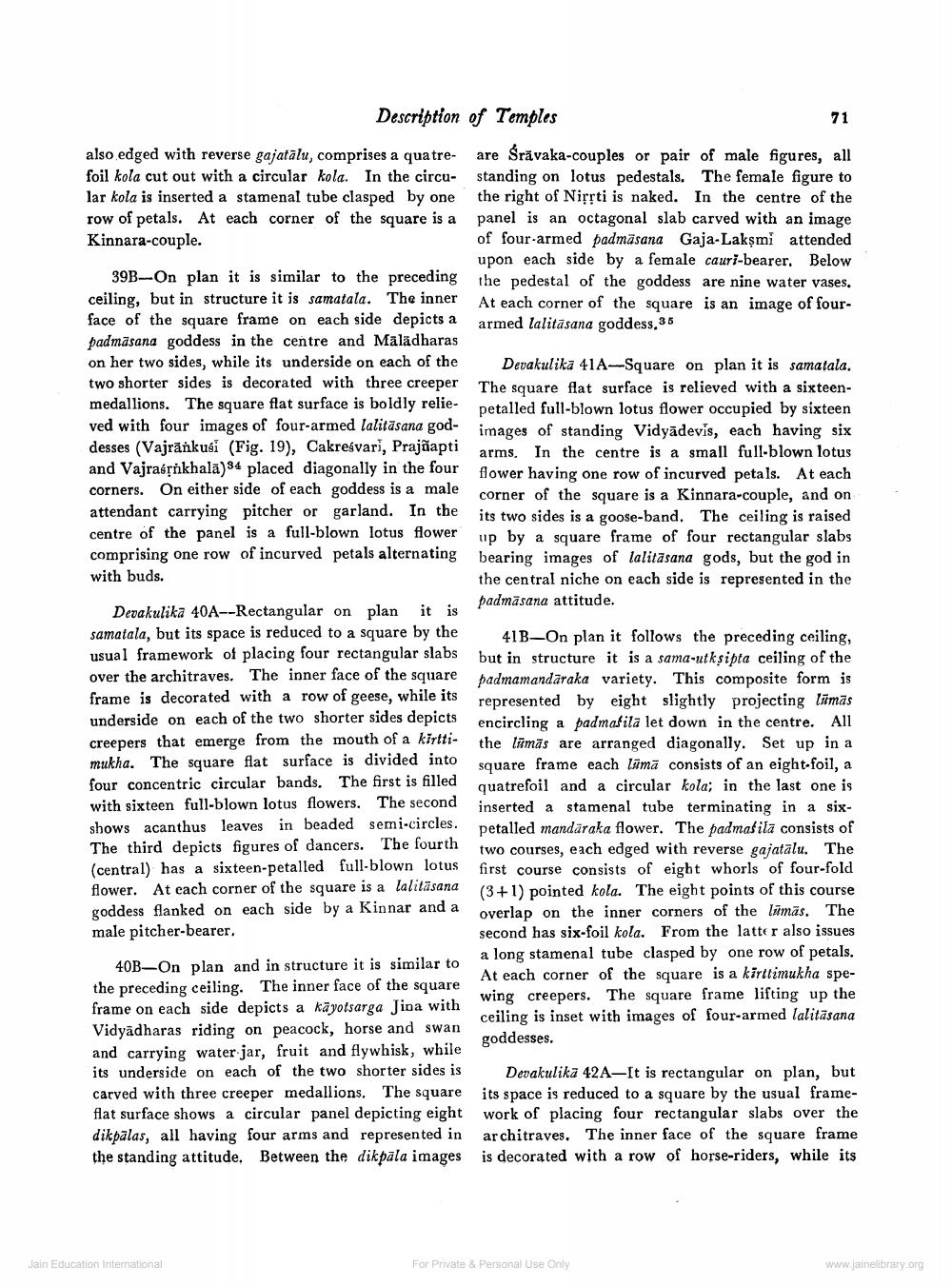________________
Description of Temples
71
also edged with reverse gajatālu, comprises a quatre are Srāvaka-couples or pair of male figures, all foil kola cut out with a circular kola. In the circu- standing on lotus pedestals. The female figure to lar kola is inserted a stamenal tube clasped by one the right of Nirrti is naked. In the centre of the row of petals. At each corner of the square is a panel is an octagonal slab carved with an image Kinnara-couple.
of four-armed padmāsana Gaja-Lakşmi attended
upon each side by a female cauri-bearer. Below 39B-On plan it is similar to the preceding the pedestal of the goddess are nine water vases. ceiling, but in structure it is samatala. The inner At each corner of the square is an image of fourface of the square frame on each side depicts a armed lalitāsana goddess. 35 padmāsana goddess in the centre and Maladharas on her two sides, while its underside on each of the Devakulika 41A-Square on plan it is samatala. two shorter sides is decorated with three creeper The square flat surface is relieved with a sixteenmedallions. The square flat surface is boldly relie
petalled full-blown lotus flower occupied by sixteen ved with four images of four-armed lalitāsana god
images of standing Vidyādevis, each having six desses (Vajrānkusi (Fig. 19), Cakresvari, Prajāapti
arms. In the centre is a small full-blown lotus and Vajraérkhalā)84 placed diagonally in the four
flower having one row of incurved petals. At each corners. On either side of each goddess is a male
corner of the square is a Kinnara-couple, and on attendant carrying pitcher or garland. In the its two sides is a goose-band. The ceiling is raised centre of the panel is a full-blown lotus flower up by a square frame of four rectangular slabs comprising one row of incurved petals alternating bearing images of lalitasana gods, but the god in with buds.
the central niche on each side is represented in the
. . Devakulika 40A--Rectangular on
padmasana attitude.
plan it is samatala, but its space is reduced to a square by the 41B-On plan it follows the preceding ceiling,
but in structure it is a sama-utk sipta ceiling of the over the architraves. The inner face of the square badmamandāraka variety. This composite form is frame is decorated with a row of geese, while its
represented by eight slightly projecting lūmās underside on each of the two shorter sides depicts
encircling a padmafila let down in the centre. All creepers that emerge from the mouth of a kirtti
the limās are arranged diagonally. Set up in a mukha. The square flat surface is divided into
square frame each lūmā consists of an eight-foil, a four concentric circular bands. The first is filled quatrefoil and a circular kola; in the last one is with sixteen full-blown lotus flowers. The second inserted a stamenal tube terminating in a sixshows acanthus leaves in beaded semi-circles. petalled mandāraka flower. The padmašila consists of The third depicts figures of dancers. The fourth
two courses, each edged with reverse gajatalu. The (central) has a sixteen-petalled full-blown lotus
first course consists of eight whorls of four-fold flower. At each corner of the square is a lalitäsana
(3+1) pointed kola. The eight points of this course goddess flanked on each side by a Kinnar and a
overlap on the inner corners of the limās. The male pitcher-bearer,
second has six-foil kola. From the latter also issues
a long stamenal tube clasped by one row of petals. 40B-On plan and in structure it is similar to
At each corner of the square is a kiritimukha spethe preceding ceiling. The inner face of the square
wing creepers. The square frame lifting up the frame on each side depicts a käyotsarga Jina with
ceiling is inset with images of four-armed lalitäsana Vidyadharas riding on peacock, horse and swan
goddesses. and carrying water jar, fruit and flywhisk, while its underside on each of the two shorter sides is Devakulika 42A-It is rectangular on plan, but carved with three creeper medallions. The square its space is reduced to a square by the usual frameflat surface shows a circular panel depicting eight work of placing four rectangular slabs over the dikpalas, all having four arms and represented in architraves. The inner face of the square frame the standing attitude. Between the dikpala images is decorated with a row of horse-riders, while its
Jain Education International
For Private & Personal use only
www.jainelibrary.org




